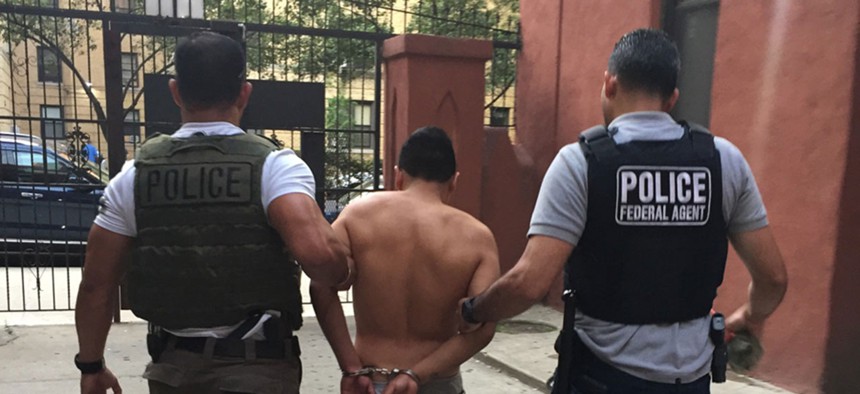The Trump Administration is Hiding Data About How Its Crackdown on Illegal Immigration is Going
ICE won't say what it does with undocumented immigrants it asks sheriffs and local police to detain.
For a president who vowed to keep the nation informed about the threats posed by illegal immigration, Donald Trump has been uncharacteristically tight-lipped about what he’s portrayed as a key strategy against it.
When undocumented people are jailed for other crimes, US Immigration and Customs Enforcement (ICE) regularly asks police departments and sheriff’s offices to hold them after their sentences end so its agents can pick them up and deport them. For years, the federal government has seen such requests, or “detainers,” as a way to multiply its limited resources for apprehending the millions of people in the country illegally. The Trump White House has been particularly adamant that cities and counties honor detainers. Ignoring them, as many jurisdictions (a.k.a. “sanctuary cities”) do, leads to the release of dangerous criminals who put the American public at risk, federal officials say.
But under the Trump administration, ICE has become mysteriously secretive about the ultimate fate of people held under detainers.
The Transactional Record Access Clearinghouse (TRAC) at Syracuse University, which gathers such information through Freedom of Information Act (FOIA) requests, says that until January ICE was giving it details about these people, including their criminal history and whether they were ultimately arrested or deported. All TRAC is getting now is the number of detainers requested.
The missing data “provide fundamental information about what’s going on in federal enforcement in immigration laws and the role that detainers play in that process,” said Susan Long, TRAC’s director. The data are needed not only to gauge whether the Trump administration is fulfilling its campaign promises to crack down on illegal immigration, but also because even if detainees are undocumented, they have rights. Those include due process and not being held in jail without probable cause.
ICE told Quartz it didn’t have information about the fate of those detainees, and said that information about their criminal records should be requested through a FOIA request.
TRAC, which sued ICE over its refusal to hand over the statistics earlier this year, has received varying explanations from government officials. First they said the data didn’t exist, says Long. Then ICE admitted it had the information, but no longer wanted to make it public. Later still, it told TRAC that officials “couldn’t process [TRAC’s] requests because officials were unable to remember where to look to find information” about the detainees.
This is what ICE told Quartz:
“Due to ongoing litigation, ICE in unable to comment on TRAC’s claims. However, lack of comment should not be construed as agreement or stipulation with any of the allegations. In DHS’s homeland security mission, our trained law enforcement professionals adhere to the Department’s mission, uphold our laws while continuing to provide our nation with safety and security.”
The lack of data is concerning because the Trump administration has been ramping up the number of detainers it issues—though as of June, the latest month for which data is available, they still hadn’t reached the peak levels of the early Obama years.
The use of detainers could also become more widespread under a proposed plan (paywall) that would theoretically protect sheriff’s offices from getting sued if they comply with the requests. Without statistics, it’s going to be impossible to tell how effective the expansion is.
In the past, ICE hasn’t been very diligent about following up on detainers: It arrested fewer than half of the immigrants it asked local officials to detain from October 2014 to November 2016, according to a TRAC analysis. Even fewer were ultimately deported. Moreover, it’s not even clear whether those arrests and deportations were the result of a detainer or some other ICE operation, TRAC said.
The agency doesn’t even have a good handle on the detainers that are denied by police and sheriffs. Earlier this year, it had to cancel the publication of a Trump-ordered report meant to expose alleged “sanctuary cities” because it couldn’t get the data right.
Another key piece of information ICE is withholding is the detainees’ criminal records, or lack thereof, which it used to release in great detail in the past. Those statistics would show how much the government is spending to go after immigrants who pose no threat to society.
ICE might well be reluctant to release the data if they show a) that the detainer program in fact results in very few deportations and arrests, or b) that it’s targeting non-criminal immigrants. Either of these would dismantle president Donald Trump’s claim, so popular with his base, that sanctuary cities are harboring criminals and that his administration is cracking down on them. But without the numbers, we don’t know the truth.



